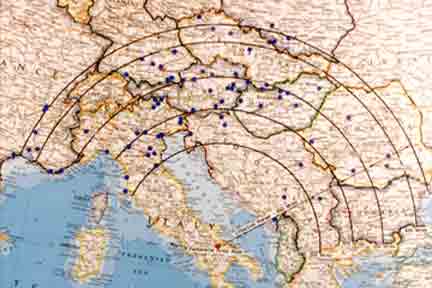Regardless of the U.S. Armed Forces branch of service (Army, Marines, Navy, Coast Guard, Air Force) much of the development of US Armed Forces military parachuting development has strong connection to the establishment of the US Forest Service’s Smoke Jumping operations that began to be considered in 1939. It should also be noted the US Forest Service began supply and resupply airdropping operations in the fighting of Forest fires in 1929 and although the parachuting in of fire fighters was considered during the years between 1929 and 1939 such ideas were discarded until 1939 as being too dangerous and completely impractical.
The first operational fire jumps were made in the Nez Perce National Forest on July 12, 1940 by Rufus Robinson and Earl Cooley.
During June 1940 four U.S. Army staff officers visited the Smoke Jumper training camp at Missoula, Montana. One of these, Major William Cary Lee, later employed Forest Service techniques and ideas in organizing the first paratroop training at Fort Benning, Georgia. The footnote in the U.S. Forest Service Smoke Jumper history states “Major Lee subsequently commanded the 101st Airborne Division which he took to England and trained for the Normandy invasion. He became first Chief of the Airborne Command and is regarded as the unquestioned father of U.S. airborne doctrine.”
The U.S. Smoke Jumper history also discloses it trained the first Army Air Force physician, Dr. Leo P. Martin, in July 1940 and subsequently other flight surgeons and medics assigned to various Army Air Force’s Air Rescue squadrons in 1940/41. Dr. Leo P. Martin was killed in a plane crash on 25 October 1942.
More history to follow.
The first operational fire jumps were made in the Nez Perce National Forest on July 12, 1940 by Rufus Robinson and Earl Cooley.
During June 1940 four U.S. Army staff officers visited the Smoke Jumper training camp at Missoula, Montana. One of these, Major William Cary Lee, later employed Forest Service techniques and ideas in organizing the first paratroop training at Fort Benning, Georgia. The footnote in the U.S. Forest Service Smoke Jumper history states “Major Lee subsequently commanded the 101st Airborne Division which he took to England and trained for the Normandy invasion. He became first Chief of the Airborne Command and is regarded as the unquestioned father of U.S. airborne doctrine.”
The U.S. Smoke Jumper history also discloses it trained the first Army Air Force physician, Dr. Leo P. Martin, in July 1940 and subsequently other flight surgeons and medics assigned to various Army Air Force’s Air Rescue squadrons in 1940/41. Dr. Leo P. Martin was killed in a plane crash on 25 October 1942.
More history to follow.
Last edited:

